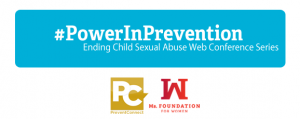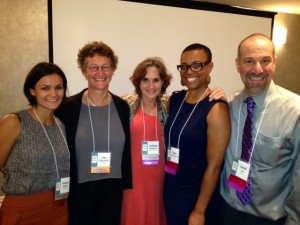Inspiring a movement: Ending child sexual abuse at the 2013 National Sexual Assault Conference
This a a guest blog by Natalie Sullivan, Interim Program Officer, Safety at the Ms. Foundation for Women.
Last week, the Ms. Foundation for Women hosted a mini track on child sexual abuse prevention at the National Sexual Assault Conference in Hollywood, Calif. In partnership with PreventConnect, a project of the California Coalition Against Sexual Assault, OAASIS Oregon, Kingsbridge Heights Community Center, Ping Chong + Co., Prevent Child Abuse North Carolina and Samaritan Counseling Center, Ms. hosted five workshops on child sexual abuse prevention.

The 2013 National Sexual Assault Conference (NSAC) kicked off with flying colors on the morning of Aug. 28, 2013 – the 50th anniversary of the March on Washington for Jobs and Freedom. Opening speaker Lynn Rosenthal of the Office on Violence Against Women set the tone for the conference by offering that “there is a connection between the work [we’re] doing for women’s freedom and King’s work.” Faye Washington, of the YWCA Los Angeles, added, “Change will not come if we wait for some other person or some other time.” With such calls to action, 1,400 of us from across the U.S. spent the next three days gathered together to “Inspire a Movement, Invest in Change, and Imagine…” what a world without sexual assault would look like, and what it would take to build a vibrant movement to arrive there.
I was thrilled and humbled to be in the presence of a diverse range of movement makers. From service providers to therapists to policy makers to teachers to activists (and many, many more), we roamed the halls, meeting rooms and streets of Hollywood strategizing about how to end the culture of violence and sexual abuse that is so pervasive in our lives and communities. The Ms. Foundation, alongside our grantee partners, was lucky enough to host five workshops specific to ending child sexual abuse – an issue that too often has fallen on the periphery of and between existing movements – with the guiding belief that ending child sexual abuse is one of the most strategic actions we can take to improve the safety of communities everywhere. Our mini track, “Building a Movement to End Child Sexual Abuse,” highlighted several cutting-edge strategies currently led by our grantee partners across the U.S. to prevent child sexual abuse.

We opened our mini track with Foundations for Change: Sharing Key Approaches to Ending Child Sexual Abuse, hosted by David Lee, Leona Smith DiFaustino, Cordelia Anderson and Joan Tabachnick. Drawing upon lessons learned and strategies shared throughout our and PreventConnect’s National Web Conference Series to End Child Sexual Abuse, this workshop led attendees through an introduction to the various strategies currently used in the field to prevent child sexual abuse, including policy advocacy, faith-based organizing, perpetrator prevention and survivor activism.
Next, Christi Hurt and Sarah Vidrine of Prevent Child Abuse North Carolina led a workshop on what it took to build a statewide coalition in North Carolina focused on creating a state primary prevention policy package to end child sexual abuse. Christi and Sarah walked attendees through the process of building a coalition that brings diverse communities, multidisciplinary teams and the voice of survivors to the table, while maintaining focus on one sole objective. The workshop proved to be a fertile space for the exchange of ideas, examination of how to overcome challenges and exploration of how other states might be able to take on such a model.
Our third workshop, Convening to End Child Sexual Abuse: A Strategic Choice for Movement Building, was led by Klarissa Oh, Linda Crockett, Cordelia Anderson, Billye Jones Mulraine, Christi Hurt, Randy Ellison and myself. During this workshop, we explored why convening is key to movement building and why storytelling is crucial in the work we do to end violence. We invited attendees to consider how they might do the same in their own work.
Day two of our mini track kicked off with Linda Crockett and Deb Helt of Samaritan Counseling Center’s Safe Church Project. Linda and Deb showcased the Safe Church project, an interactive one-year ecumenical group training designed to shift congregational culture to inspire prevention of child sexual abuse within churches and communities. Currently launched in Pennsylvania, they are planning to take the project national soon.
Finally, our mini track closed with an arts-based workshop led by Sara Zatz and Amita Swadhin, who hosted a documentary screening of Ping Chong + Co’s Secret Survivors. In addition to showing the documentary, Sara and Amita guided attendees through an interactive discussion and creative workshop on using the arts to end child sexual abuse. They presented the Secret Survivors toolkit designed to complement the documentary and support community and education partners in sparking dialog to end child sexual abuse.
This conference enabled child sexual abuse to come out of the shadows and into the foreground into a national dialog of violence prevention, and I thank CALCASA and their partners, National Sexual Violence Resource Center and Pennsylvania Coalition Against Rape for their vision in organizing this conference. I continue to be moved and pushed in many ways by the brilliance and depth of knowledge of those who do this work. For me, conferences reinforce the benefit of face-to-face exchanges of ideas, breaking down silos, so that we continuously remember how each of our pieces of work supports the greater whole. This year’s NSAC fully lived up to those expectations, laying the groundwork for progress and continued movement building to end violence.
This article first appeared on the Ms. Foundation for Women blog.
